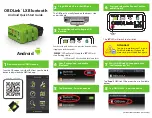
Form # 147083
Issue 01/07
89
UNLOADING & ASSEMBLY
974 FLEX HEADER: WING FLOAT SET-UP AND PRE-DELIVERY CHECK
9.
Check overall balance of header. Adjust so that minimum pressure on cutterbar will float wings up or
down.
NOTE:
Use the gauge on the adapter float optimizer to take note of changes in load on cutterbar.
a) Ensure top link is in mid-range header angle position and float lockout is disengaged on both adapter
springs and wing float.
b) Raise header to 12” (300 mm) cutterbar
height. Place two 6” (150 mm) blocks under
cutterbar, just inboard of hinge points.
c) Lower header until cutterbar just touches
blocks. Observe and record gauge position
on the float optimizer. This corresponds to
approximately zero force on cutterbar.
Movement from this position will be used to
estimate changes to force on cutterbar.
d) With blocks positioned as above, lower
header until dividers just move down to
ground. Observe and record gauge position
on the float optimizer when dividers move
down.
NOTE:
Wings should start to move down
before float optimizer gauge has moved one
full number. Full frown should occur before
gauge has moved two full numbers. If not, this is an indication that there is excessive friction and/or
mis-adjustment in the flex linkage. Be sure the adapter front skid plate is not causing binding at
cutterbar, and the flex linkage is moving freely.
e) Raise header 12” (300 mm) and remove blocks.
f) Lower header until wings float up to straight position and center section of cutterbar touches ground.
Observe and record gauge position on the float optimizer when center section of cutterbar moves
down.
g) Raise header 12” (300 mm) and put 6” (150 mm) blocks under dividers at ends of header.
h) Lower header until center section of cutterbar
touches ground. Observe and record gauge
position on the float optimizer when center
section of cutterbar moves down. Cutterbar
should begin going into smile before float
optimizer gauge has moved one full number,
and full smile should occur before gauge has
moved two full numbers.
i) Raise header 12” (300 mm) and remove
blocks.
j) Lower header until wings float down to
straight. Observe and record gauge position
on the float optimizer.
k) Adjust bell cranks as required to balance
wings, For example, raise top link pin if it
takes more force on cutterbar (as indicated by
gauge position on the float optimizer) to move
wings down than up. In cases where a frown
bias is desired, if it takes one full number for
the wings to start to smile, it should only take
from 8/10
th
to one full number to start to
frown.
10. Check to ensure full flex range is achieved by
observing position of pin (M). If pin does not reach
ends of horizontal slot (N) at full-smile and full-
frown, see Header Technical Manual.
Continued next page….
USE FLOAT OPTIMIZER GAUGE TO
BALANCE WINGS
CHECK FOR FULL FLEX RANGE
M
N
Summary of Contents for 973
Page 2: ...Inside Front Cover blank...





































